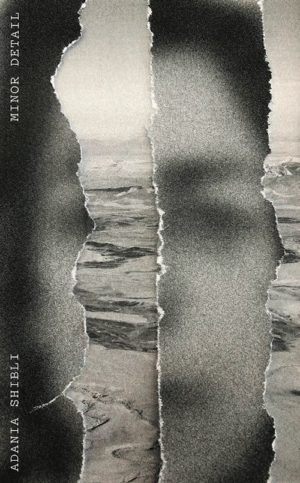You have no items in your cart. Want to get some nice things?
Go shopping
In 2016, Adania Shibli published a short but densely filled work, a compact and intricate book detailing a particularly horrific but peripheral brutality committed by Israeli occupying forces in the Negev and the search to ascertain the exact details of this passing fact. تفصيل ثانوي: رواية, or Minor Detail: A Novel, as it’s known in English, was translated from the Arabic by Elisabeth Jaquette, published in 2020, and longlisted for the 2021 International Booker Prize. The translation’s spare and unornamented style takes no liberties with the original text. To take such liberties would itself be an act of erasure, of alteration, one more such act against Shibli’s homeland, Palestine.
The book, separated into two parts, is a tale of two overlapping locales. The parts are roughly the same in length (about fifty pages each of a one-hundred-and-five-page novella) and approximately equal in narrative duration: Both focus on a few days in the lives of their respective central characters. Similarly, these characters are both fixated with a pursuit, one for Bedouins in the Negev, the other for information regarding an atrocity, and both, separated by a quarter-century, arrive at a similarly bleak but ambiguous conclusion. In style, however, they vary. The first part is strictly imagistic, resembling what might be fairly referred to as the new cinematic literature:
He stood by the doorway breathing in the clean air, as his eyes tracked the soldiers carrying the bed and the dog following them. When they reached the second hut, they set it down in front of the door. The guard walked to the water tank and turned on the tap, letting water rush into a bucket placed carefully underneath. After a moment, the soldier turned off the tap and carried the bucket back to the second hut. As soon as he got there, he poured the water onto the girl’s motionless body; some splashed onto the sand, which as usual refused to let water travel across it, and instead greedily sucked the moisture down into its depths.
In following each action, they seem to divide themselves into visual frames, the tension building from expectation alone, from the question – Why is this what we’re being shown? This owes much in feeling to the slow, quiet cinema of Michelangelo Antonioni or Lav Diaz. And in a book so brief, whatever Shibli chooses to focus on is necessarily magnified, necessarily gains in importance, and becomes highly sensitised to the potential of visual metaphor, of water absorbed into sand. If an editor were to transform the novel’s narrative past-tense into a simple and continuous present tense, the specificity of the actions would read something like a screenplay. And of the features that make up cinematic literature, this is key.
The dog approached his right hand where it was hanging in the air and began sniffing it. Suddenly, he clamped his hand around its jaws; the dog’s stifled barking made his palm vibrate, and the space filled with the sound of its paws slipping on the floor as it tried to flee his grasp.
The writing is sensorial, shifting focus from image to sound to image. And though the images are laid out in clean prosaic sequences, the naturalism is punctuated with poetry and underpinned with allegory and metaphor. A deadly infection that the first character, an Israeli officer referred to only as he, sustains from a spider bite grows as a malignant wound, driving his increasingly delirious and aggressive actions, while remaining a guarded secret.
Eventually, when I’ve lost all hope of resting, I pick up the maps from the seat next to me. First, I open the Israeli one and try to determine my position, relying on the number that appeared on the last sign I saw along the road. It seems I simply have to drive on a straight course, albeit a short one, and I’ll soon reach my next destination, which appears on the map as a small black dot, practically the only one in a sea of yellow.
In the second part, the perspective shifts. The narrator speaks in the first person, raising the question whether she’d been speaking all along. The text moves from cinematic minimalism to literary maximalism, much further away from Raymond Carver than from Thomas Bernhard or Horacio Castellanos Moya. The external has become internal: neurotic, fixated. The narrator is searching for details of a crime that we’ve already painstakingly witnessed. Its blurred scenes now seem unreachable, as the narrator, an office-worker in contemporary Ramallah, follows her intuition and her obsessions to fill them in. It’s here that the work is closest to a parable of its own creation.
In the book’s first part, every possible minor detail is exhausted in portraying the original crime. No evidence is left untouched. But absences remain. The desert as a blank backdrop of enormous vastness makes any and every detail immense and intricate on its expanse, but moral details seem imperceptible, viewed from a distance. The desert is a kind of screen, the action played out on it. And the shift of perspective is jarring. The narrator searches. She searches museums and obscure archives, scours the puzzling multiplicities of maps – themselves the indexes of conquerors and conquered, of oppressors and oppressed.
Next, I pick up the map showing the country until 1948, but I snap it shut as horror rushes over me. Palestinian villages, which on the Israeli map appear to have been swallowed by a yellow sea, appear on this one by the dozen, their names practically leaping off the page.
The novel is a constant shifting of perspective: internal to external, historical to personal, official to unofficial, oppressors’ to resistors’. Shibli ensures that the exact history, with its crucial dates, is touched on while revealing the discrepancies in historical accounts. In the wake of a catastrophic past, the present experiences a crisis of memory. The complexity of the catastrophe outweighs the capacity for the details that can be remembered. What’s considered a minor detail from one angle – the dots on a map – from another perspective is the major landscape of a life. But this outlook is gradually swallowed up.
Occasionally, he says, clashes did occur between members of the settlement and the few Arabs left in the area, whose livestock sometimes devoured crops on settlement land. Did that ever lead to someone being killed? A man or a woman, on either side? He replies that he doesn’t know of any incidents like that.
The lines between narrated perception and narrative reality are obfuscated. What’s real and what’s metaphor becomes a kind of haunting, when the only objective basis for what’s actual and what’s perceived is the official story, riddled with holes, redactions, and hidden atrocities. Man, not the tank, shall prevail, reads a plaque in Hebrew. Seen again, the meaning changes. The oppressed become the oppressors. The angle changes from frame to frame.
I listen intently to the sounds of the shelling, and the heaviness of the sound translates my distance from the place being bombed. It’s far, past the Wall. In Gaza, or maybe Rafah. Bombing sounds very different depending on how close one is to the place being bombed, or how far. The rumblings from the shelling aren’t strong at all, and the noise isn’t unsettling; rather, it’s a deep, heavy sound, like a languorous pounding on a massive drum. And the bombs causing it don’t shake the building I’m in, even though the walls are thin and made of light wood; they don’t shatter the glass, even though the windows are closed.
The work that Shibli has produced is itself an act of protest against the confusion of lost voices and mislaid accounts, and is highly political. It is a novel of protest, a work of resistance against injustice. Driven forward by a need to uncover the truth, the novel in its two parts moves from sweeping agoraphobia to gripping claustrophobia. It demands empathy but seldom shows it, amplifying the scale of the catastrophe. The tension, the ceaseless and captivating pace of the book over its one-hundred-and-five pages, comes from its refusal to look away. The invisible is made visible. The out-of-focus is rewound and replayed. And the minor details are lost in yellow seas.
Minor Detail
By Adania Shibli
Trans. Elisabeth Jaquette
144/120 pages. New Directions/Fitzcarraldo Editions
About Joshua Calladine-Jones
Joshua Calladine-Jones is a writer and the literary-critic-in-residence at Prague Writers' Festival. His work has appeared or is forthcoming in 3:AM, The Stinging Fly, Freedom, The Anarchist Library, and Literární.cz. His short collection Constructions is to be published by tall-lighthouse in 2021.




